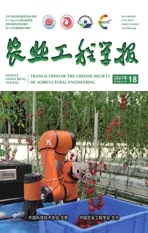多温区网带式干燥机热流场分析与结构优化
2021-11-24龚中良王鹏凯李大鹏易宗霈
龚中良,王鹏凯,李大鹏,易宗霈,刘 豪,文 韬,张 镇
多温区网带式干燥机热流场分析与结构优化
龚中良,王鹏凯,李大鹏※,易宗霈,刘 豪,文 韬,张 镇
(中南林业科技大学机电工程学院,长沙 410004)
为实现连续式干燥机温度分区要求,该研究设计了一种基于分层孔板送风的四层网带式干燥机。首先,采用计算流体力学(Computational Fluid Dynamics,CFD)方法优化了气流分配室出风孔结构参数;并以油茶籽为干燥对象,基于油茶籽干燥动力学特性,建立了干燥机CFD模型,以温度不均匀系数作为单层温度均匀性、温度分层偏离度作为分层温度显著性的评价指标,研究了送风温度自上而下逐层递减和递增两种工况下其内部温度场分布规律。研究结果表明,在送风温度递减和递增两种工况下,自上而下各层温度不均匀系数分别为3.08%、2.00%、1.89%、1.60%和2.37%、2.04%、2.42%、3.31%,递减工况下温度分层偏离度为4.94%,递增工况下温度分层偏离度为3.57%。可有效实现温度分区的功能。为了进一步优化干燥机温度均匀性和温度分层有效性,为每一层气流分配室设置阻流板。结构优化后,对于温度递减和递增工况,各层温度不均匀系数的降幅分别达到了13.0%~66.3%和24.0%~51.7%,温度分层偏离度降幅分别达到了10.9%和10.1%,分层温度均匀性和温度分区效果得到改善。研究结果可为网带式干燥机进行分区可控变温干燥提供参考依据。
数值模拟;优化;干燥机;温度分区;油茶籽
0 引 言
多层网带式干燥机主要用于颗粒状物料的干燥,其占地面积小、可实现物料连续干燥[1-2]。目前,网带式干燥机的研究主要是从结构参数和工作参数等方面进行。张航等[3-4]分析了堆积厚度、温度、风速与含湿率对槟榔的影响,在干燥机入口处设置导流板,提高了输送带上干燥物的含水率均匀性;颜建春等[5]对比了花生干燥机空载工况下有无导风组件时,空气穿过承料板后的流场分布特性,提高了通风的均匀性;Zhang等[6-7]研究了水产饲料在不同进料厚度下的气流分布,进料厚度为40 mm时,气流速度分布的均匀性较好;Zhang等[8]研究了输送带位置对气流分布的影响,比较了不同输送带位置下的速度的均匀性,得出较佳的输送带位置。
数值模拟可以模拟干燥机在多种条件下的工况,得出其内部的流场及温度场,不需要复杂的试验。代建武等[9]对气体射流干燥机的气流分配室进行数值模拟,通过平板扰流模型解决气流分布不均的问题;吴敏等[10]对红外热风联合干燥机的气流分配室设置二级均风板,并对稳压腔的不同厚度进行数值模拟分析,确定气流分配室的结构及最优稳压腔厚度;Yue等[11]研究速度对多层网带式干燥机内部气流分布的影响,通过数值模拟获得其速度分布并通过试验验证,得出较佳优化方案;Li等[12]采用LES模型对干燥机数值模拟,并对结构进行优化,当速度为1.5 m/s,横纵比较小时,可以提供更好的干燥流动环境,有助于物料干燥并节省能源。
目前网带式干燥机的送风方式包括顶部送风,底部送风和侧面送风等[13-15]。其中,由于热风密度小,顶部送风会使热风无法到达底部部分区域,存在干燥死角;底部送风和侧面送风可以有效避免干燥死区,但由于是统一送风,无法根据物料干燥工艺曲线有效控制干燥机内不同区域的温度。
网带式干燥机常用于颗粒状物料的干燥,近年来开始被用于干燥油茶籽[16]。采用热风方式干燥油茶籽具有较好的技术经济性[17],并且采用变温干燥有助于提高油茶籽品质[18]。为了满足变温干燥需求,本文设计了一种多温区网带式干燥机,采用计算流体力学方法对该干燥机的流场和温度场进行数值模拟研究,并对干燥机结构进行优化,拟为网带式干燥机进行分区可控变温干燥提供了参考依据。
1 工作原理与结构
多温区网带式干燥机工作时,物料自顶部进料口进入输送链网干燥,链网层之间往复运行将物料送至出料口。根据物料的干燥工艺,不同温度的热风从每层送风管道的进风口分别进入,并从侧面进入均流箱,最后从均流箱的顶部出风孔流出,该送风方式每层之间相互独立,实现每层温度独立控制,且使热风直达网带,与干燥物料直接接触,减少了热风传递过程中的热损失,热风经过干燥物料后变为湿空气,从干燥机顶部的出风口排出,同时针对不同物料的干燥工艺中干燥时间要求,每层设置一个独立电机,可以控制每层的运行时间。
多温区网带式干燥机结构如图1所示,包含了4层网带,其中均流箱和送风管道构成了气流分配室,每一层网带均对应于一个独立的气流分配室。气流分配室结构如图2所示,由于链网中间设置有支撑轮,因此设置有左右两块均流箱。主要结构参数如表1所示。
1. 均流箱 2.传动系统 3.进料口 4.出风口 5.保温板 6.进风口 7.机架 8.输送网带 9.送风管道 10.出料口
1. Flow equalizing room 2.Transmission system 3.Material inlet 4.Air outlet 5.Insulation board 6.Air inlet 7.Frame 8.Conveying net belt 9.Air inlet pipe 10.Material outlet
注:为长度方向;为高度方向;为宽度方向。
Note:is the length direction;is the height direction;is the width direction.
图1 多温区网带式干燥机结构图
Fig.1 Structure diagram of multi-temperature zone belt dryer
1.均流箱 2.送风管道 3.进风口 4.出风孔
1.Flow equalizing room 2.Air inlet pipe 3.Air inlet 4.Air outlet
注:为出风孔间距,mm;为出风孔直径,mm。下同。
Note:is the distance between air outlets, mm;is the diameter of air outlet, mm. Same as below.
图2 气流分配室结构示意图
Fig.2 Structure diagram of air distribution room
2 模型建立及数值计算方法
首先对干燥机的关键部件气流分配室进行速度场数值模拟,通过优化出风孔设计实现均匀送风。出风孔布置方式考虑了出口孔径、孔间距(图2)和排列方式3个因素,并根据预仿真试验分析结果,孔径设置15、20、25 mm这 3个水平;孔间距根据孔径设置=2、3、4、5这4个水平;排列方式设置均匀排列和交叉排列两个水平。然后基于优化后的气流分配室结构,建立干燥机模型,以油茶籽作为干燥物料为例,对干燥机内温度场进行数值模拟,分析干燥机在不同干燥温度曲线下的性能,最后,对干燥机结构进行进一步优化。
2.1 基本假设与数学模型
针对网带式干燥机的结构,分别建立气流分配室、网带式干燥机的物理模型,在模拟过程中引入以下简化条件:
1)干燥介质空气视为不可压缩理想气体,且其粘性系数为常数。
2)壁面视为绝热壁面,不与外界进行热量交换。
3)由于进出料口在干燥过程中常闭,忽略进出料口对流场的影响。
4)油茶籽层简化为多孔介质模型,采用孔隙率、能量源项和赋予初始温度来描述油茶籽的性质和干燥过程。
计算域内包含了空气和油茶籽。其中空气满足连续介质假设,采用连续性方程、动量方程和能量方程来描述其流动和传热特性[19-21]。由于本研究主要关注干燥机尺度下的流场和温度场,所以采用多孔介质模型描述空气流过油茶籽层的阻力损失,并将该损失赋予动量方程阻力源项;另外将油茶籽从空气中吸热的热量赋予能量方程的源项。
2.1.1 多孔介质模型
将油茶籽层看作各向同性均匀多孔介质模型,热空气穿过油茶籽物料层看作多孔介质内的流动,该过程压力损失即为动量方程中的阻力损失项。根据Ergun公式,得出油茶籽的黏性阻力系数与惯性阻力系数[22-23]。
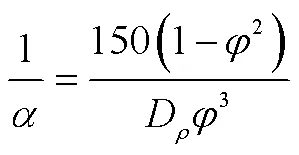
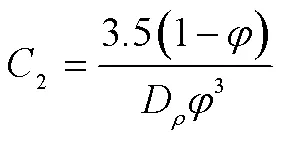
2.1.2 湍流模型

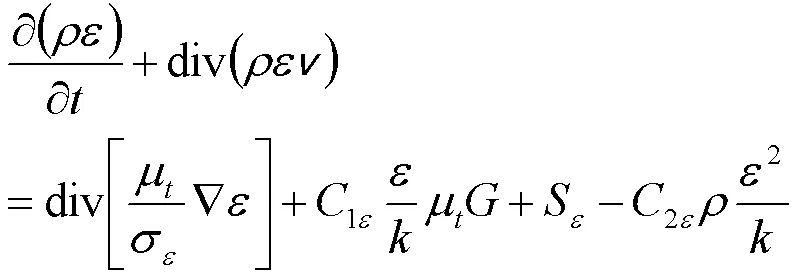
2.2 边界条件与参数设置
首先针对气流分配室的模拟,其进风口设置为速度进口边界条件,速度取2 m/s,出风孔设置为压力出口。
而在干燥机尺度的模拟中,每一层气流分配室的进风口均设置为速度进口边界条件,速度取2 m/s。干燥机出风口设置为压力出口。油茶籽物料层设置为多孔介质,设置油茶籽初始温度为50 ℃,油茶籽参数设置如表2所示[25]。根据干燥机尺寸,设置油茶籽物料层的大小为1 100 mm×700 mm×25 mm。
为了研究多温区网带式干燥机的温度分层效果,设定两种不同的干燥温度曲线。考虑网带式干燥机具有4个入口,2个出口,每一层网带均对应于一个油茶籽物料层,忽略链网链条等的影响。每个入口的温度可按照物料干燥工艺所需要的温度设置。具体地,每一层气流分配室进口的送风温度分别按从上往下逐层递减(70 ℃-65 ℃-60 ℃-55 ℃)和递增(55 ℃-60 ℃-65 ℃-70 ℃)设置。需要说明的是,本文中采用的干燥温度曲线仅为了验证网带式干燥机是否可以有效实现温度分层,以考察该干燥机结构是否也可以用于其他需要进行变温干燥的物料。

表2 油茶籽物料参数
同时,油茶籽在干燥过程中将吸收空气中的热量,因此为油茶籽施加一个能量源项,该能量的数值大小对应能量方程中的内热源,具体数值根据油茶籽干燥模型计算。根据文献[26],其干燥模型为

其中MR为水分比,%;为干燥温度,℃;为干燥时间,h。
水分比的定义如式(6)所示。
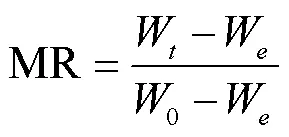
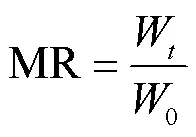
假设油茶籽吸热量全部用于蒸发其内部的水分,所以能量源项可采用式(8)计算。



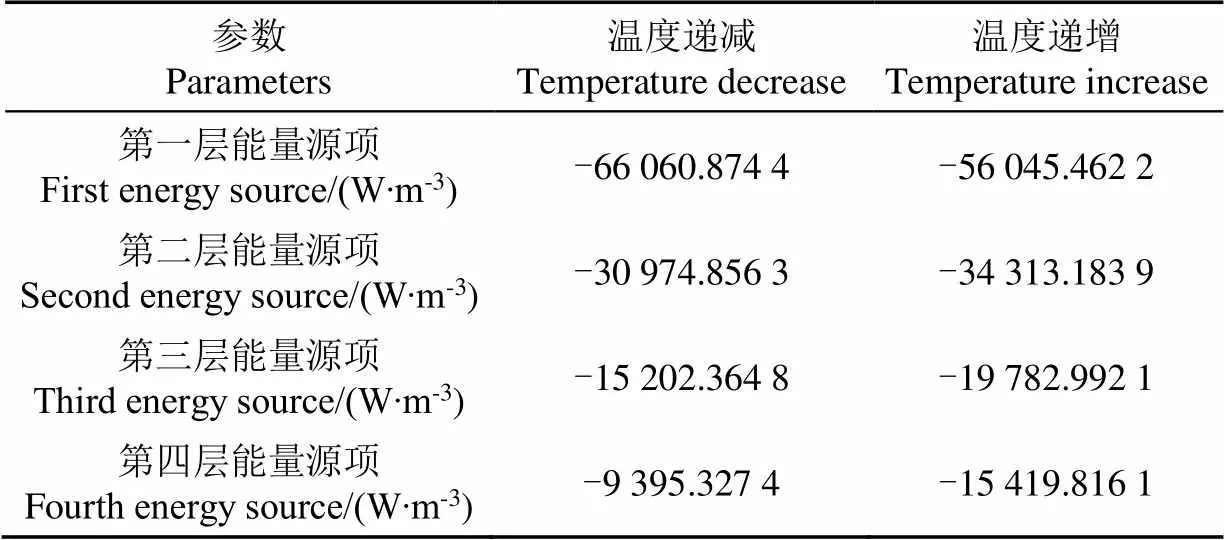
表3 温度递减及递增工况下各层油茶籽能量源项参数
2.3 网格划分与求解方法
利用ICEM将气流分配室进行网格划分,主要为结构化的六面体网格单元,对出风孔处进行加密处理,根据孔径、孔间距及排列方式的不同,其网格数量的范围为1 581 432~7 821 436。生成的网格如图3a所示。
利用Fluent Meshing将干燥机模型进行网格划分,由于干燥机模型较为复杂,对模型进行非结构处理,对物料层进行加密处理,得到的网格数量为9 555 952。生成的网格如图3b所示。
气流分配室与干燥机均采用时间步长为0.1 s的瞬态模拟,对于能量方程,收敛标准设定为10-6,对于其他方程,收敛标准设定为10-3。模型的几何尺寸大,网格数量大,内存使用率高,因此,采用压力基求解器,压力、动量、能量方程采用二阶离散方法,湍动能(方程)和湍流耗散率(方程)方程采用一阶离散方法,时间项采用一阶隐式离散方法,采用SIMPLEC算法对离散方程进行求解。
2.4 评价指标
2.4.1 速度不均匀系数
引入速度不均匀系数对气流分配室出口的速度均匀性进行定量分析[30-32]。该值越小,表明出口的速度均匀性越好。
2.4.2 温度不均匀系数
定义温度不均匀系数对干燥机内的不同截面的温度场的温度均匀性进行定量分析[30-32]。其值越小,表明温度分布越均匀。
2.4.3 温度分层偏离度
式(11)定义了温度分层偏离度。该评价指标从整体上衡量网带式干燥机的温度分层是否符合预期,该值越小,物料层的送风温度越接近于每一层进风温度,干燥机的工作效果越理想。

2.5 模型验证
2.5.1 气流分配室
为验证气流分配室仿真模型的可靠性,搭建了气流分配室的实体模型,采用的试验仪器包括150FLJ7工频离心风机,RS-FS-120-9TH管道式风速传感器,德图405i风速仪和SIN-R6000C无纸记录仪。
试验中,首先通过调节离心风机频率,保证气流分配室进口风速稳定在2 m/s左右,随后依次测量每个出口处的风速,测量过程重复3次,取平均值作为出口平均风速,最后将试验出口风速与仿真结果进行对比。
以出口孔径为=20 mm、孔间距为=55 mm的气流分配室为例,验证仿真模型的准确性。试验结果与仿真结果的速度对比图如图4所示。从图中看出,在=-0.275 m、=-0.950 m处速度差距较小,=-0.575 m、=-0.650 m处速度差距较大。从整体上看,试验结果小于仿真的结果,主要原因是,仿真设置的进口速度为均匀分布,而试验时只有风速传感器附近为2 m/s,其他位置风速由于壁面效应的影响小于2 m/s,从而导致整体速度偏小,但试验得到的出口风速与仿真结果的变化趋势一致,说明仿真模型较为准确。
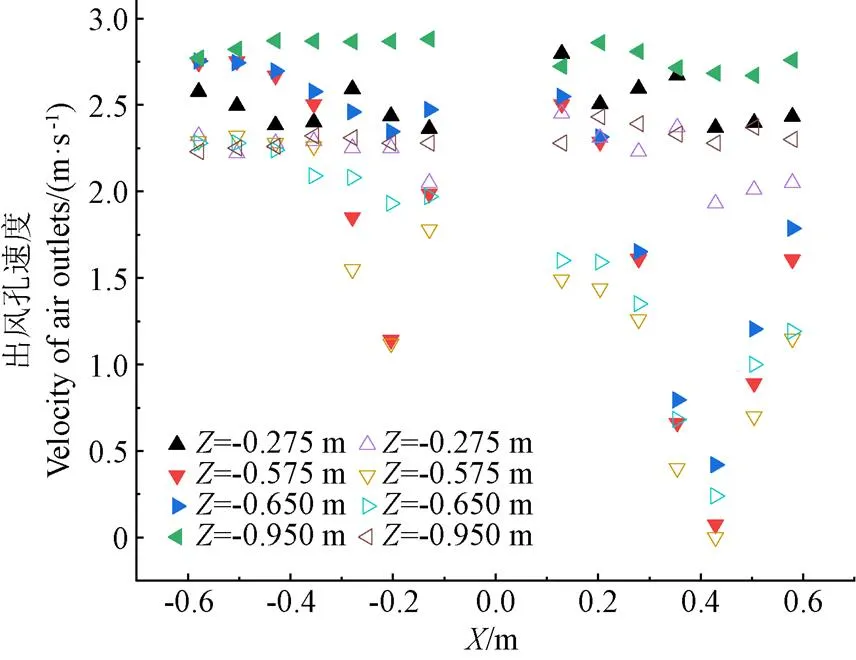
注:实心符号表示模拟结果;空心符号表示试验结果。
2.5.2 干燥机
对干燥机的温度场模型进行试验验证,搭建了油茶籽干燥试验平台(图5)。采用的试验仪器包括Fotric236红外成像测温仪,RS-WS-I20-2温湿度变送器。
本文采用的油茶籽为中南林业科技大学望城区雪峰山油茶基地的油茶籽,经测量,试验样品直径为22 mm~26 mm。试验时,将刚脱蒲后热油茶籽单层平铺在油茶籽干燥机的每一层中,送风温度自上而下设置70 ℃-65 ℃-60 ℃-55 ℃,通过红外成像测温仪在每层的观察口测量干燥腔每一层的温度,验证各油茶籽层温度的均匀程度和干燥机层与层之间的分层效果。
试验结果与仿真结果对比的温度不均匀系数如表4所示。从表中可以看出,其温度不均匀系数较小,温度分布较为均匀,试验得出的各层的温度不均匀系数高于仿真值,主要原因是油茶籽平铺的厚度不够均匀,物料层较厚处的温度较低,导致偏高。

表4 干燥机试验结果与模拟结果温度不均匀系数对比
3 结果与讨论
3.1 气流分配室出风孔排列方式对速度分布的影响
均匀排列与交叉排列速度云图分布如图6所示。从图中看出,不同的排列方式影响其出风孔速度的均匀性,从气流分配室的右侧均流箱速度云图中看出,均匀排列出风孔速度较低的个数较少,而交叉排列下每一列出风孔中均存在速度较低的出风孔;均匀分布下气流分配室出风孔速度均匀性优于交叉排列,均匀排列下其速度不均匀系数为9.2%,交叉排列下其速度不均匀系数为13.53%。因此,下面主要对均匀排列的情况进行分析讨论。
3.2 气流分配室出风孔孔径和孔间距对速度分布的影响
均匀排列下孔间距对出风孔速度分布的影响和均匀排列下孔径对出风孔速度分布的影响如表5所示。从表中看出,孔径相同的情况下,出风孔的速度随着孔间距的增大逐渐增大,其中=2时,速度偏差最大为2.81 m/s,且存在速度几乎为0的出风孔;随着孔间距的增大,速度偏差逐渐减小,均匀性改善,且在=5时,其速度偏差最小,为1.66 m/s,其均匀性较好。
从表5中还看出,在=5时,=15 mm对应的最大速度为4.22 m/s,最小速度为2.16 m/s;=20 mm时,最大速度为4.21 m/s,最小速度为2.55 m/s;=25 mm时,最大速度为4.67 m/s,最小速度为2.50 m/s。因此,在=20 mm时,速度偏差最小,出风孔速度较为均匀。
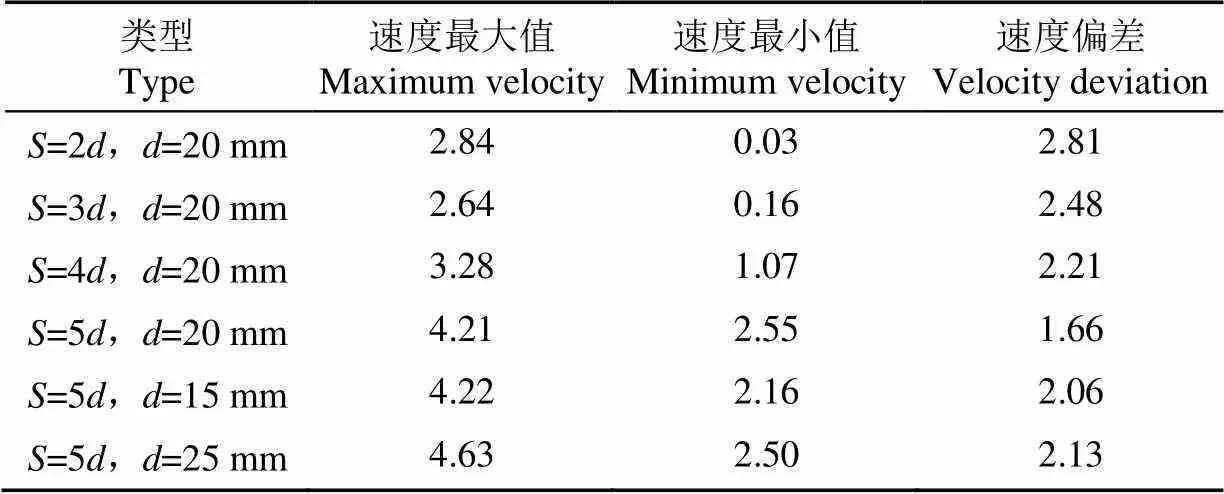
表5 均匀排列不同孔径与不同孔间距下速度分布
图7对比了均匀排列下不同孔间距和孔径下的速度不均匀系数。不同孔径之间的速度不均匀性系数差距不大,出风孔处均匀程度较为一致,而不同孔间距下的速度不均匀性系数差距较大,当=20 mm,=2时,均匀性最差,其速度不均匀系数为77.36%,当=20 mm,=5时,均匀性较好,其速度不均匀系数减小至9.2%。
3.3 多温区网带式干燥机温度分布特性
以油茶籽物料层底部截面为例,分析在温度递减和递增两种干燥温度曲线下不同高度截面的温度分布,模拟结果如图8所示。
从图8中看出,分析面各点温度低于各层对应的送风温度,且送风温度越低,两者之间的差值越大。主要原因在于油茶籽表面温度低于每层送风温度且其在干燥过程中吸收热量,导致附近空气温度有所降低。
对于温度递增干燥曲线而言,自上而下各层温度不均匀系数分别为1.56%、2.04%、2.42%、3.31%,温度分层偏离度为3.57%;而对于温度递减干燥曲线而言,自上而下各层温度不均匀系数分别为3.08%、2.00%、1.89%、1.60%,温度分层偏离度为4.94%。可见,对于两种干燥曲线而言,温度不均匀系数和温度分层偏离度均较小,说明所设计的网带式干燥机结构可以获得预期的效果。
同时看出,送风温度越高,该层的温度不均匀系数也越高,这主要是由于气流分配室的两个均流箱中间存在间隙,均流箱出来的热风不能直接送到中间区域,导致该区域温度受油茶籽表面温度的影响较大;同时均流箱中间的空隙也会使其他层的热风通过,从而影响中间区域温度不能达到预期值。
3.4 优化设计
为了克服上述均流箱中间空隙导致的问题,进一步提高温度均匀性和温度分层有效性,对原始设计结构进行进一步地优化。在每一层气流分配室的两个均流箱之间设置一块阻流板,如图9所示,拟隔断不同层空气通过中间空隙进行混合。根据两个均流箱之间的孔隙大小,设置阻流板尺寸为720 mm×144 mm× 3 mm。
优化前后的各层温度不均匀系数如表6所示。在温度递减工况下,自上而下各层温度不均匀系数分别由3.08%、2.00%、1.89%、1.60%降低至2.43%、1.74%、1.30%、0.54%,各层降幅分别达到21.1%、13.0%、31.2%、66.3%;温度均匀性改善;温度分层偏离度从优化前的4.94%降低到了优化后的4.4%,降幅达到了10.9%。在温度递增工况下,自上而下各层温度不均匀系数分别由2.37%、2.04%、2.42%、3.31%降低至1.56%、1.55%、1.71%、1.60%,各层降幅分别达到34.2%、24.0%、29.3%、51.7%;温度均匀性改善;温度分层偏离度从优化前的3.57%降低到了优化后的3.21%,降幅达到了10.1%。

表6 温度递增和递减工况下优化前后各层温度不均匀系数
4 结 论
1)气流分配室的结构影响其出风均匀性,孔间距对均匀性的影响最大,而出风孔的排列方式、孔径的影响较小;当=20 mm,=5时,均匀性较好,其速度不均匀系数为9.2%。
2)本文所设计的多温区网带式干燥机在初始设计结构下可实现多种温度分层的需求;在温度递增干燥曲线条件下,自上而下各层温度不均匀系数分别为2.37%、2.04%、2.42%、3.31%,温度分层偏离度为3.57%;而在温度递减干燥曲线条件下,各层温度不均匀系数分别为3.08%、2.00%、1.89%、1.60%,温度分层偏离度为4.94%;温度不均匀系数和温度分层偏离度均较小。
3)通过设置阻流板,可以进一步优化干燥机温度分层效果和均匀性。在温度递增和递减两种工况下,温度分层偏离度从优化前的3.57%和4.94%分别降低到了3.21%和4.40%,降幅分别达到了10.1%和10.9%;各层的温度均匀性也达到了不同程度的改善。
[1] 赵丽娟,李建国,潘永康. 真空带式干燥机的应用及研究进展[J]. 化学工程,2012,40(3):25-29.
Zhao Lijuan, Li Jianguo, Pan Yongkang. Application and research progress of vacuum belt dryer[J]. Chemical Engineering, 2012, 40(3): 25-29. (in Chinese with English abstract)
[2] Mohammad K, Reza A C, Ali M N. Mass transfer characteristics of eggplant slices during length of continuous band dryer[J]. Heat and Mass Transfer, 2017, 53(6): 2045-2059.
[3] 张航,邓胜祥. 基于Shannon-Wiener指数的干燥过程中物料含水率均匀性计算及验证[J]. 农业工程学报,2016,32(20):290-297.
Zhang Hang, Deng Shengxiang. Calculation and validation of moisture uniformity in drying process based on Shannon-Wiener index[J]. Transactions of the Chinese Society of Agricultural Engineering (Transactions of the CSAE), 2016, 32(20): 290-297. (in Chinese with English abstract)
[4] Zhang H, Deng S X. Numerical simulation of moisture-heat coupling in belt dryer and structure optimization[J]. Applied Thermal Engineering, 2017, 127: 292-301.
[5] 颜建春,谢焕雄,魏海,等. 5H-1.5A型花生换向通风干燥机研制[J]. 农业工程学报,2019,35(10):9-18.
Yan Jianchun, Xie Huanxiong, Wei Hai, et al. Development of 5H-1.5A peanut reversing ventilation dryer[J]. Transactions of the Chinese Society of Agricultural Engineering (Transactions of the CSAE), 2019, 35(10): 9-18. (in Chinese with English abstract)
[6] Zhang Q, Huang M F, Wang J, et al. Investigation on airflow distribution under different feed thickness combined CFD modeling and experimental verification[J]. Drying Technology, 2020, 39(3): 1-18.
[7] Zhang P F, Mu Y B, Shi Z Z, et al. Computational fluid dynamic analysis of airflow in belt dryer: effects of conveyor position on airflow distribution[J]. Energy Procedia, 2017, 142: 1367-1374.
[8] Zhang P F, Wu P P, Zhang Q, et al. Optimization of feed thickness on distribution of airflow velocity in belt dryer using computational fluid dynamics[J]. Energy Procedia, 2017, 142: 1595-1602.
[9] 代建武,肖红伟,谢龙,等. 倾斜料盘式气体射流冲击干燥机设计与试验[J]. 农业机械学报,2015,46(7):238-244.
Dai Jianwu, Xiao Hongwei, Xie Long, et al. Design and experiment of tilted tray air-impingement dryer[J]. Transactions of the Chinese Society for Agricultural Machinery, 2015, 46(7): 238-244. (in Chinese with English abstract)
[10] 吴敏,段豪,王振文,等. 基于温湿度控制的红外热风联合干燥机设计与试验[J]. 农业机械学报,2020,51(S1):483-492.
Wu Min, Duan Hao, Wang Zhenwen, et al. Design and experiment of infrared-hot air combined dryer based on temperature and humidity control[J]. Transactions of the Chinese Society for Agricultural Machinery, 2020, 51(S1): 483-492. (in Chinese with English abstract)
[11] Yue X Y, Zhao J H, Shi E J, et al. Analysis of air velocity distribution in a multilayer conveyor dryer by computational fluid dynamics[J]. Asia-Pacific Journal of Chemical Engineering, 2010, 2(2): 108-117.
[12] Li J, Zhao P, Shi Y J, et al. Analysis of transient inhomogeneous flow and thermal characteristics in a drying room via large eddy simulation[J]. Chemical Engineering & Technology, 2020, 43(7): 1372-1382.
[13] 张鹏飞,吴鹏鹏,张琦,等. 带式烘干机中水产饲料料层厚度对其表面风速场分布的影响[J]. 农业工程学报,2019,35(7):288-294.
Zhang Pengfei, Wu Pengpeng, Zhang Qi, et al. Effects of aquatic feed layer thickness on distribution of airflow velocity on feed layer surface in belt dryer[J]. Transactions of the Chinese Society of Agricultural Engineering (Transactions of the CSAE), 2019, 35(7): 288-294. (in Chinese with English abstract)
[14] 李克峰. 旋片干燥机内流场和温度场数值模拟[D]. 沈阳:东北大学,2009.
Li Kefeng. Numerical Simulation of Fluid Field and Temperature Field Within the Rotary Vane Dryer[D]. Shenyang: Northeastern University, 2009. (in Chinese with English abstract)
[15] 巨浩羽. 基于温湿度控制的热风干燥装置设计与试验[D]. 北京:中国农业大学,2016.
Ju Haoyu. The Design and Experiment of Hot Air Drying Technology Based on Being Controlled Temperature and Humidity[D]. Beijing: China Agricultural University, 2016. (in Chinese with English abstract)
[16] 龚中良,陈昌和,陶宇超,等. 油茶籽网带式干燥机的温度均匀性仿真研究[J]. 农机化研究,2021,43(6):42-46.
Gong Zhongliang, Chen Changhe, Tao Yuchao, et al. Simulation study on temperature uniformity of camellia seed net dryer[J]. Journal of Agricultural Mechanization Research, 2021, 43(6): 42-46. (in Chinese with English abstract)
[17] Zhu G F, Liu H, Xie Y C, et al. Postharvest processing and storage methods for camellia oleifera seeds[J]. Food Reviews International, 2020, 36(4): 319-339.
[18] 刘军,胡光华,龚丽,等. 变温热泵干燥工艺对油茶品质的影响[J]. 食品研究与开发,2020,41(3):72-75,158.
Liu Jun, Hu Guanghua, Gong Li, et al. Effect of drying process of variable temperature heat pump on the quality ofseed[J]. Food Research and Development, 2020, 41(3): 72-75, 158. (in Chinese with English abstract)
[19] Zawawi M H, Saleha A, Salwa A, et al. A review: Fundamentals of computational fluid dynamics (CFD)[C]//AIP Conference Proceedings. AIP Publishing LLC, 2018, 2030(1): 020252.
[20] 李玉哲,艾永生,刘卫真,等. 基于CFD的某减速器飞溅润滑仿真分析与验证[J]. 航空动力学报,2020,35(7):1482-1488.
Li Yuzhe, Ai Yongsheng, Liu Weizhen, et al. Splash lubrication simulation analysis and verification of a gearbox based on CFD[J]. Journal of Aerospace Power, 2020, 35(7): 1482-1488. (in Chinese with English abstract)
[21] 孙伟. 热泵干燥箱内部流场的数值模拟及特性分析[D]. 昆明:云南师范大学,2020. Sun Wei. Numerical Simulation and Characteristic Analysis of Flow Field in Heat Pump
Drying Chamber[D]. KunMing: Yunnan Normal University, 2020. (in Chinese with English abstract)
[22] 冯超. 列置双TIG电弧高速焊接熔池传热与流动行为数值分析[D]. 济南:山东大学,2020.
Feng Chao. Numerical Simulation of Heat Transfer and Dynamics in Molten Pool of High Speed Tandem TIG Welding[D]. Jinan: Shandong University, 2020. (in Chinese with English abstract)
[23] 刘德钊,辛宜聪,荣莉,等. 猪活动区域多孔介质模型及其阻力系数的CFD模拟[J]. 中国农业大学学报,2021,26(6):53-62.
Liu Dezhao, Xin Yicong, Rong Li, et al. CFD simulation on porous media model and resistant coefficients of pig occupied zone[J]. Journal of China Agricultural University, 2021, 26(6): 53-62. (in Chinese with English abstract)
[24] Ahmed A, Haithem N, Abdallah B, et al. Effect of the turbulence model on the simulation of the air flow in a solar chimney[J]. International Journal of Thermal Sciences, 2018, 130: 423-434.
[25] 陈昌和. 油茶籽网带式干燥机温度场数值模拟与结构优化研究[D]. 长沙:中南林业科技大学,2020.
Chen Changhe. Numerical Simulation and Structural Optimization Study on Temperature Field of Camellia Seed Net Belt Dryer[D]. Changsha: Central South University of Forestry and Technology, 2020. (in Chinese with English abstract)
[26] 王凤贺,丁冶春,陈鹏枭,等. 油茶籽热风干燥动力学研究[J]. 农业机械学报,2018,49(S1):426-432.
Wang Fenghe, Ding Yechun, Chen Pengxiao, et al. Investigation on hot-air drying of camellia oleifera seeds[J]. Transactions of the Chinese Society for Agricultural Machinery, 2018, 49(S1): 426-432. (in Chinese with English abstract)
[27] Doymaz I. Effect of pre-treatments using potassium metabisulphide and alkaline ethyl oleate on the drying kinetics of apricots[J]. Biosystems Engineering, 2004, 89(3): 281-287.
[28] 王亚萍,石晓丽,姚小华,等. 适宜含水率保持油茶籽贮藏品质[J]. 农业工程学报,2016,32(4):256-261.
Wang Yaping, Shi Xiaoli, Yao Xiaohua, et al. Suitable moisture content maintaining storage quality of oil-tea camellia seed[J]. Transactions of the Chinese Society of Agricultural Engineering (Transactions of the CSAE), 2016, 32(4): 256-261. (in Chinese with English abstract)
[29] 周杨,徐俐,王凯燕,等. 不同贮藏条件下油茶籽品质及生理活性[J]. 食品科学,2011,32(24):291-295.
Zhou Yang, Xu Li, Wang Kaiyan, et al. Quality and physiological changes of Camellia oleifera seed under storage conditions[J]. Food Science, 2011, 32(24): 291-295. (in Chinese with English abstract)
[30] 韩文霆,吴普特,杨青,等. 喷灌水量分布均匀性评价指标比较及研究进展[J]. 农业工程学报,2005,21(9):172-177.
Han Wenting, Wu Pute, Yang Qing, et al. Advances and comparisons of uniformity evaluation index of sprinkle irrigation[J]. Transactions of the Chinese Society of Agricultural Engineering (Transactions of the CSAE), 2005, 21(9): 172-177. (in Chinese with English abstract)
[31] 陶红歌,陈焕新,谢军龙,等. 基于面积加权平均速度和质量加权平均速度的流体流动均匀性指标探讨[J]. 化工学报,2010,61(S2):116-120.
Tao Hongge, Chen Huanxin, Xie Junlong, et al. Flow uniformity index based on area-weighted and mass-weighted average velocity[J]. Journal of Chemical Industry and Engineering, 2010, 61(S2): 116-120. (in Chinese with English abstract)
[32] 冉景煜,邓庆波,牛俊天,等. 湿法脱硫塔内流场均匀性影响因素及其评价方法[J]. 动力工程学报,2020,40(10):825-831.
Ran Jingyu, Deng Qingbo, Niu Juntian, et al. Influence factors and evaluation method on the uniformity of flow field in a WFGD tower[J]. Journal of Chinese Society of Power Engineering, 2020, 40(10): 825-831. (in Chinese with English abstract)
Analysis and structure optimization of the temperature and flow fields of the belt dryer with multi-temperature zones
Gong Zhongliang, Wang Pengkai, Li Dapeng※, Yi Zongpei, Liu Hao, Wen Tao, Zhang Zhen
(,,410004,)
Variable temperature during drying can usually be utilized to improve agricultural product quality in recent years. However, it is difficult to control intentionally the temperature distribution inside traditional multi-layer belt dryers. In this study, a novel type of belt dryer was proposed to select proper structural parameters of the air distribution chamber, further evaluating the performance of the new dryer. Four layers of conveyor belts were also added into the air distribution chamber, under which to supply directly hot air for drying products. Firstly, computational fluid dynamics (CFD) was used to optimize the structural parameters of air outlets in a single air distribution chamber, thereby reducing the velocity non-uniformity coefficient (VNUC). The specific structural parameters included the diameter of the outlet orifice, the distance between orifices, and the arrangement of orifices. Secondly, a CFD model was developed for the whole belt dryer with optimized structure parameters of air distribution chambers. Specifically, the drying material was selected as Camellia oleifera seeds, which were granular suitable for belt dryers. A porous media model was also adopted to evaluate the drying effect of seeds on airflow distribution, considering that the material absorbed the heat from surrounding air, according to the drying kinetics of the material. Thirdly, two typical profiles of air temperature were determined for the inlet of each air distribution chamber, including the inlet temperature increasing layer by layer from top to bottom, while the decreasing counterpart. Finally, two evaluation indicators were defined, including the temperature non-uniformity coefficient (TNUC) and temperature stratification deviation (TSD). The TNUC was used to evaluate temperature uniformity adjacent to each conveyor belt, while the TSD indicated to what extent the actual temperature deviated from the set one. The simulation results show that the distance between orifices presented the most significant effect on air distribution. There was no marked effect on the diameter of the outlet orifice, and the arrangement of orifices. Subsequently, the optimal combination of structural parameters was obtained, where the minimum VNUC was achieved concurrently. Additionally, the independent temperature control can be expected to be effectively realized for each layer inside the dryer during the simulation. In particular, the TNUC of each layer from top to bottom were 3.08%, 2.00%, 1.89%, and 1.60% under the decreasing inlet temperature profile, whereas, 2.37%, 2.04%, 2.42%, and 3.31% under the increasing one. Specifically, the TSDs were 4.94% and 3.57% under the above two profiles, respectively. Furthermore, it was also found that the uniformity and deviation of temperature can be further improved by installing the deflector horizontally in the middle of each layer. Consequently, the deflector decreased the TNUC of each layer by 21.1%、13.0%、31.2%、66.3% for the decreasing profiles, and 34.2%、24.0%、29.3%、51.7% for the increasing one, respectively, whereas, the TSDs were reduced by 10.9% and 10.1%, respectively, compared with the original structure. This finding can provide a valuable reference for the multi-layer belt dryers to perform variable temperature drying with independent temperature control for different zones.
numerical simulation; optimization; dryer; temperature divisions;seeds
10.11975/j.issn.1002-6819.2021.18.005
S226.6
A
1002-6819(2021)-18-0040-08
龚中良,王鹏凯,李大鹏,等. 多温区网带式干燥机热流场分析与结构优化[J]. 农业工程学报,2021,37(18):40-47.doi:10.11975/j.issn.1002-6819.2021.18.005 http://www.tcsae.org
Gong Zhongliang, Wang Pengkai, Li Dapeng, et al. Analysis and structure optimization of the temperature and flow fields of the belt dryer with multi-temperature zones[J]. Transactions of the Chinese Society of Agricultural Engineering (Transactions of the CSAE), 2021, 37(18): 40-47. (in Chinese with English abstract) doi:10.11975/j.issn.1002-6819.2021.18.005 http://www.tcsae.org
2021-06-06
2021-09-14
湖南省科技计划重点研发项目(2018NK2066);湖南省教育厅科学项目(18B192,20A515);湖南省自然科学基金(2020JJ4142);湖南省林业杰青培养科研项目(XLK202108-7)
龚中良,博士,教授,研究方向为智能农业装备及自动化。Email:gzlaa@163.com
李大鹏,博士,讲师,研究方向为智能干燥技术及装备。Email:dapengli@csuft.edu.cn
中国农业工程学会高级会员:龚中良(E041201190S)
